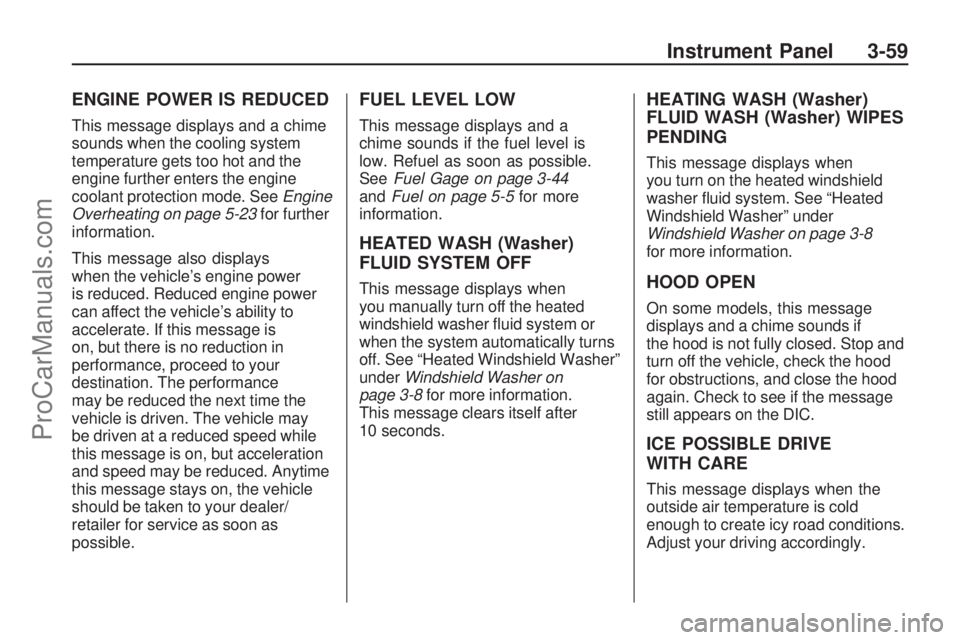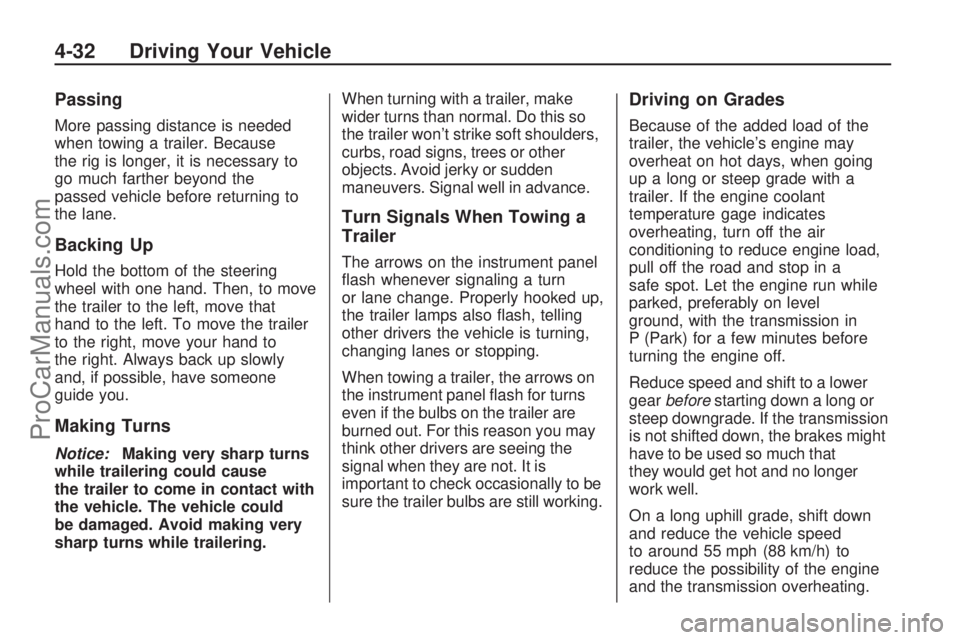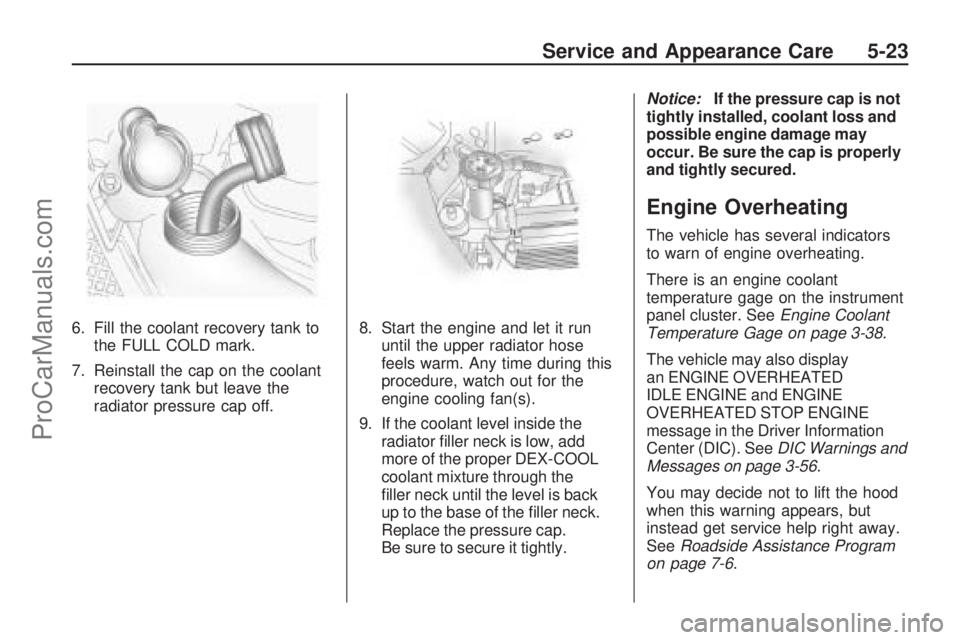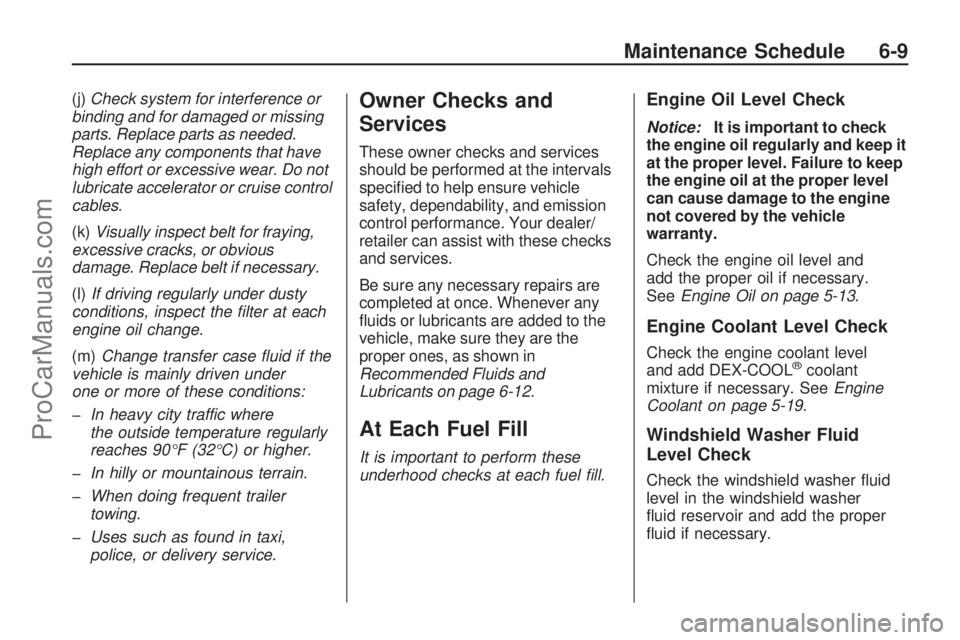coolant level SATURN OUTLOOK 2009 Owners Manual
[x] Cancel search | Manufacturer: SATURN, Model Year: 2009, Model line: OUTLOOK, Model: SATURN OUTLOOK 2009Pages: 432, PDF Size: 2.48 MB
Page 181 of 432

ENGINE POWER IS REDUCED
This message displays and a chime
sounds when the cooling system
temperature gets too hot and the
engine further enters the engine
coolant protection mode. SeeEngine
Overheating on page 5-23for further
information.
This message also displays
when the vehicle’s engine power
is reduced. Reduced engine power
can affect the vehicle’s ability to
accelerate. If this message is
on, but there is no reduction in
performance, proceed to your
destination. The performance
may be reduced the next time the
vehicle is driven. The vehicle may
be driven at a reduced speed while
this message is on, but acceleration
and speed may be reduced. Anytime
this message stays on, the vehicle
should be taken to your dealer/
retailer for service as soon as
possible.
FUEL LEVEL LOW
This message displays and a
chime sounds if the fuel level is
low. Refuel as soon as possible.
SeeFuel Gage on page 3-44
andFuel on page 5-5for more
information.
HEATED WASH (Washer)
FLUID SYSTEM OFF
This message displays when
you manually turn off the heated
windshield washer �uid system or
when the system automatically turns
off. See “Heated Windshield Washer”
underWindshield Washer on
page 3-8for more information.
This message clears itself after
10 seconds.
HEATING WASH (Washer)
FLUID WASH (Washer) WIPES
PENDING
This message displays when
you turn on the heated windshield
washer �uid system. See “Heated
Windshield Washer” under
Windshield Washer on page 3-8
for more information.
HOOD OPEN
On some models, this message
displays and a chime sounds if
the hood is not fully closed. Stop and
turn off the vehicle, check the hood
for obstructions, and close the hood
again. Check to see if the message
still appears on the DIC.
ICE POSSIBLE DRIVE
WITH CARE
This message displays when the
outside air temperature is cold
enough to create icy road conditions.
Adjust your driving accordingly.
Instrument Panel 3-59
ProCarManuals.com
Page 282 of 432

Passing
More passing distance is needed
when towing a trailer. Because
the rig is longer, it is necessary to
go much farther beyond the
passed vehicle before returning to
the lane.
Backing Up
Hold the bottom of the steering
wheel with one hand. Then, to move
the trailer to the left, move that
hand to the left. To move the trailer
to the right, move your hand to
the right. Always back up slowly
and, if possible, have someone
guide you.
Making Turns
Notice:Making very sharp turns
while trailering could cause
the trailer to come in contact with
the vehicle. The vehicle could
be damaged. Avoid making very
sharp turns while trailering.When turning with a trailer, make
wider turns than normal. Do this so
the trailer won’t strike soft shoulders,
curbs, road signs, trees or other
objects. Avoid jerky or sudden
maneuvers. Signal well in advance.
Turn Signals When Towing a
Trailer
The arrows on the instrument panel
�ash whenever signaling a turn
or lane change. Properly hooked up,
the trailer lamps also �ash, telling
other drivers the vehicle is turning,
changing lanes or stopping.
When towing a trailer, the arrows on
the instrument panel �ash for turns
even if the bulbs on the trailer are
burned out. For this reason you may
think other drivers are seeing the
signal when they are not. It is
important to check occasionally to be
sure the trailer bulbs are still working.
Driving on Grades
Because of the added load of the
trailer, the vehicle’s engine may
overheat on hot days, when going
up a long or steep grade with a
trailer. If the engine coolant
temperature gage indicates
overheating, turn off the air
conditioning to reduce engine load,
pull off the road and stop in a
safe spot. Let the engine run while
parked, preferably on level
ground, with the transmission in
P (Park) for a few minutes before
turning the engine off.
Reduce speed and shift to a lower
gearbeforestarting down a long or
steep downgrade. If the transmission
is not shifted down, the brakes might
have to be used so much that
they would get hot and no longer
work well.
On a long uphill grade, shift down
and reduce the vehicle speed
to around 55 mph (88 km/h) to
reduce the possibility of the engine
and the transmission overheating.
4-32 Driving Your Vehicle
ProCarManuals.com
Page 299 of 432

A. Radiator Pressure Cap. See
Cooling System on page 5-19.
B. Engine Coolant Recovery Cap.
SeeCooling System on
page 5-19.
C. Remote Negative (−) Terminal.
SeeJump Starting on page 5-30.
D.Underhood Fuse Block on
page 5-94.
E. Remote Positive (+) Terminal.
SeeJump Starting on page 5-30.
F.Power Steering Fluid on
page 5-25.
G. Engine Oil Fill Cap. See “When
to Add Engine Oil” underEngine
Oil on page 5-13.H. Engine Oil Dipstick. See
“Checking Engine Oil” under
Engine Oil on page 5-13.
I. Automatic Transmission Fluid
Dipstick. See “Checking the
Fluid Level” underAutomatic
Transmission Fluid on page 5-18.
J. Brake Master Cylinder Reservoir.
See “Brake Fluid” underBrakes
on page 5-27.
K.Engine Air Cleaner/Filter on
page 5-17.
L. Windshield Washer Fluid
Reservoir. See “Adding Washer
Fluid” underWindshield
Washer Fluid on page 5-26.Engine Oil
Checking Engine Oil
It is a good idea to check the engine
oil level at each fuel �ll. In order to
get an accurate reading, the oil must
be warm and the vehicle must be on
level ground.
The engine oil dipstick handle
is a yellow loop. SeeEngine
Compartment Overview on
page 5-12for the location of the
engine oil dipstick.
1. Turn off the engine and give the
oil several minutes to drain back
into the oil pan. If this is not done,
the oil dipstick might not show the
actual level.
2. Pull out the dipstick and clean
it with a paper towel or cloth,
then push it back in all the way.
Remove it again, keeping the
tip down, and check the level.
Service and Appearance Care 5-13
ProCarManuals.com
Page 307 of 432

Checking Coolant
The vehicle must be on a level
surface when checking the coolant
level.
Check to see if coolant is visible in
the coolant recovery tank. If the
coolant inside the coolant recovery
tank is boiling, do not do anything
else until it cools down. If coolant is
visible but the coolant level is not at
or above the FULL COLD mark, add
a 50/50 mixture of clean, drinkable
water and DEX-COOL coolant at the
coolant recovery tank, but be sure
the cooling system is cool before this
is done. SeeEngine Coolant on
page 5-19for more information.The coolant recovery tank cap has
this symbol on it.
When the engine is cold, the
coolant level should be at or above
the FULL COLD line marked on the
recovery tank.
When the engine is hot, the level
could be higher than the FULL COLD
line. If the coolant is below the FULL
COLD line when the engine is hot,
there could be a leak in the cooling
system.
If the coolant is low, add the coolant
or take the vehicle to a dealer/retailer
for service.
How to Add Coolant to the
Recovery Tank
{CAUTION
You can be burned if you spill
coolant on hot engine parts.
Coolant contains ethylene glycol
and it will burn if the engine parts
are hot enough. Do not spill
coolant on a hot engine.
Notice:This vehicle has a
speci�c coolant �ll procedure.
Failure to follow this procedure
could cause the engine to
overheat and be severely
damaged.
If coolant is needed, add the proper
DEX-COOL
®coolant mixture at
the coolant recovery tank.
Service and Appearance Care 5-21
ProCarManuals.com
Page 309 of 432

6. Fill the coolant recovery tank to
the FULL COLD mark.
7. Reinstall the cap on the coolant
recovery tank but leave the
radiator pressure cap off.8. Start the engine and let it run
until the upper radiator hose
feels warm. Any time during this
procedure, watch out for the
engine cooling fan(s).
9. If the coolant level inside the
radiator �ller neck is low, add
more of the proper DEX-COOL
coolant mixture through the
�ller neck until the level is back
up to the base of the �ller neck.
Replace the pressure cap.
Be sure to secure it tightly.Notice:If the pressure cap is not
tightly installed, coolant loss and
possible engine damage may
occur. Be sure the cap is properly
and tightly secured.
Engine Overheating
The vehicle has several indicators
to warn of engine overheating.
There is an engine coolant
temperature gage on the instrument
panel cluster. SeeEngine Coolant
Temperature Gage on page 3-38.
The vehicle may also display
an ENGINE OVERHEATED
IDLE ENGINE and ENGINE
OVERHEATED STOP ENGINE
message in the Driver Information
Center (DIC). SeeDIC Warnings and
Messages on page 3-56.
You may decide not to lift the hood
when this warning appears, but
instead get service help right away.
SeeRoadside Assistance Program
on page 7-6.
Service and Appearance Care 5-23
ProCarManuals.com
Page 310 of 432

If you do decide to lift the hood,
make sure the vehicle is parked
on a level surface.
Then check to see if the engine
cooling fans are running. If the
engine is overheating, both fans
should be running. If they are
not, do not continue to run the
engine and have the vehicle
serviced.
Notice:Engine damage from
running the engine without
coolant is not covered by the
warranty.
Notice:If the engine catches �re
while driving with no coolant, the
vehicle can be badly damaged.
The costly repairs would not be
covered by the vehicle warranty.
SeeOverheated Engine Protection
Operating Mode on page 5-25for
information on driving to a safe
place in an emergency.If Steam Is Coming From The
Engine Compartment
{CAUTION
Steam from an overheated engine
can burn you badly, even if you
just open the hood. Stay away
from the engine if you see or hear
steam coming from it. Turn it off
and get everyone away from the
vehicle until it cools down. Wait
until there is no sign of steam or
coolant before you open the hood.
If you keep driving when the
vehicles engine is overheated, the
liquids in it can catch �re. You or
others could be badly burned.
Stop the engine if it overheats,
and get out of the vehicle until the
engine is cool.
SeeOverheated Engine Protection
Operating Mode on page 5-25for
information on driving to a safe
place in an emergency.
If No Steam Is Coming From
The Engine Compartment
If an engine overheat warning is
displayed but no steam can be seen
or heard, the problem may not be too
serious. Sometimes the engine can
get a little too hot when the vehicle:
Climbs a long hill on a hot day.
Stops after high-speed driving.
Idles for long periods in traffic.
Tows a trailer.
If the overheat warning is displayed
with no sign of steam:
1. Turn the air conditioning off.
2. Turn the heater on to the highest
temperature and to the highest
fan speed. Open the windows as
necessary.
3. If in a traffic jam, shift to
N (Neutral), otherwise, shift
to the highest gear while
driving — D (Drive) or L (Low).
5-24 Service and Appearance Care
ProCarManuals.com
Page 313 of 432

Notice:
When using concentrated
washer �uid, follow the
manufacturer’s instructions for
adding water.
Do not mix water with
ready-to-use washer �uid.
Water can cause the solution
to freeze and damage your
washer �uid tank and other
parts of the washer system.
Also, water does not clean as
well as washer �uid.
Fill the washer �uid tank only
three-quarters full when it is
very cold. This allows for �uid
expansion if freezing occurs,
which could damage the tank if
it is completely full.
Do not use engine coolant
(antifreeze) in your windshield
washer. It can damage the
vehicle’s windshield washer
system and paint.
Brakes
Brake Fluid
The brake master cylinder reservoir
is �lled with DOT 3 brake �uid. See
Engine Compartment Overview on
page 5-12for the location of the
reservoir.
There are only two reasons why the
brake �uid level in the reservoir
might go down:
The brake �uid level goes down
because of normal brake lining
wear. When new linings are
installed, the �uid level goes
back up.
A �uid leak in the brake hydraulic
system can also cause a low �uid
level. Have the brake hydraulic
system �xed, since a leak means
that sooner or later the brakes will
not work well.Do not top off the brake �uid. Adding
�uid does not correct a leak. If �uid
is added when the linings are worn,
there will be too much �uid when new
brake linings are installed. Add or
remove brake �uid, as necessary,
only when work is done on the brake
hydraulic system.
{CAUTION
If too much brake �uid is added, it
can spill on the engine and burn, if
the engine is hot enough. You or
others could be burned, and the
vehicle could be damaged. Add
brake �uid only when work is done
on the brake hydraulic system.
When the brake �uid falls to a low
level, the brake warning light comes
on. SeeBrake System Warning
Light on page 3-36.
Service and Appearance Care 5-27
ProCarManuals.com
Page 389 of 432

Scheduled Maintenance (cont’d)
ServiceMaintenanceIMaintenance II
Inspect brake system. See footnote (a). ••
Check engine coolant and windshield washer �uid levels and add �uid as
needed. ••
Perform any needed additional services. See “Additional Required Services” in
this section. ••
Inspect suspension and steering components. See footnote (b). •
Inspect engine cooling system. See footnote (c). •
Inspect wiper blades. See footnote (d). •
Inspect restraint system components. See footnote (e). •
Lubricate body components. See footnote (f). •
Inspect throttle system. See footnote (j). •
Maintenance Schedule 6-5
ProCarManuals.com
Page 392 of 432

(d)Inspect wiper blades for wear,
cracking, or contamination. Clean
the windshield and wiper blades,
if contaminated. Replace wiper
blades that are worn or damaged.
See Windshield Wiper Blade
Replacement on page 5-38 and
Windshield, Backglass, and Wiper
Blades on page 5-88 for more
information.
(e)Make sure the safety belt
reminder light and safety belt
assemblies are working properly.
Look for any other loose or damaged
safety belt system parts. If you see
anything that might keep a safety belt
system from doing its job, have it
repaired. Have any torn or frayed
safety belts replaced. Also see
Checking the Restraint Systems
on page 1-61.(f)Lubricate all key lock cylinders,
hood latch assemblies, secondary
latches, pivots, spring anchor
and release pawl, hood and door
hinges, rear folding seats, and
liftgate hinges. More frequent
lubrication may be required when
exposed to a corrosive environment.
Applying silicone grease on
weatherstrips with a clean cloth will
make them last longer, seal
better, and not stick or squeak.
(g)A fluid loss in any vehicle
system could indicate a problem.
Have the system inspected
and repaired and the fluid level
checked. Add fluid if needed.(h)Change automatic transmission
fluid if the vehicle is mainly driven
under one or more of these
conditions:
�In heavy city traffic where the
outside temperature regularly
reaches 90°F (32°C) or higher.
�In hilly or mountainous terrain.
�When doing frequent trailer
towing.
�Uses such as found in taxi, police,
or delivery service.
(i)Drain, flush, and refill cooling
system. This service can be
complex; you should have your
dealer/retailer perform this service.
See Engine Coolant on page 5-19 for
what to use. Inspect hoses. Clean
radiator, condenser, pressure cap,
and filler neck. Pressure test the
cooling system and pressure cap.
6-8 Maintenance Schedule
ProCarManuals.com
Page 393 of 432

(j)Check system for interference or
binding and for damaged or missing
parts. Replace parts as needed.
Replace any components that have
high effort or excessive wear. Do not
lubricate accelerator or cruise control
cables.
(k)Visually inspect belt for fraying,
excessive cracks, or obvious
damage. Replace belt if necessary.
(l)If driving regularly under dusty
conditions, inspect the filter at each
engine oil change.
(m)Change transfer case fluid if the
vehicle is mainly driven under
one or more of these conditions:
�In heavy city traffic where
the outside temperature regularly
reaches 90°F (32°C) or higher.
�In hilly or mountainous terrain.
�When doing frequent trailer
towing.
�Uses such as found in taxi,
police, or delivery service.Owner Checks and
Services
These owner checks and services
should be performed at the intervals
speci�ed to help ensure vehicle
safety, dependability, and emission
control performance. Your dealer/
retailer can assist with these checks
and services.
Be sure any necessary repairs are
completed at once. Whenever any
�uids or lubricants are added to the
vehicle, make sure they are the
proper ones, as shown in
Recommended Fluids and
Lubricants on page 6-12.
At Each Fuel Fill
It is important to perform these
underhood checks at each fuel fill.
Engine Oil Level Check
Notice:It is important to check
the engine oil regularly and keep it
at the proper level. Failure to keep
the engine oil at the proper level
can cause damage to the engine
not covered by the vehicle
warranty.
Check the engine oil level and
add the proper oil if necessary.
SeeEngine Oil on page 5-13.
Engine Coolant Level Check
Check the engine coolant level
and add DEX-COOL®coolant
mixture if necessary. SeeEngine
Coolant on page 5-19.
Windshield Washer Fluid
Level Check
Check the windshield washer �uid
level in the windshield washer
�uid reservoir and add the proper
�uid if necessary.
Maintenance Schedule 6-9
ProCarManuals.com